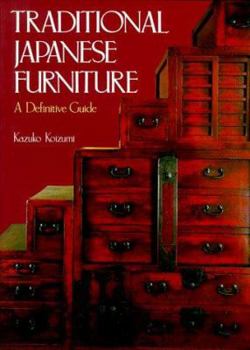Traditional Japanese Furniture
Japanese furniture has a rich heritage dating back to the seventh century. Masterful craftsmanship and aesthetic sensitivity evolved with this furniture's long history. Yet, as with much that is Japanese, these pieces find virtue in restraint. The work is compelling yet sedate, with an understated simplicity distilled from a thousand years of knowledge and careful craftsmanship. Though the West has long acknowledged the beauty and value of these objects, the history of their making--their milieu and craftsmanship-remain virtually unexplored. This volume, first published in 1986, fills that void. Author Kazuko Koizumi, a pioneer in the field, brings a thoroughness and warmth to the subject. A wealth of illustrated material puts the pieces in context. A historical account, laced with centuries-old drawings, traces the evolution of furniture design through the lens of Japan's "floor-based" culture. With 114 color plates and over 650 figures, Traditional Japanese Furniture documents and discusses the roots of more than eighty unique furniture types, including the many variations of the beloved tansu chest that has made its way into homes and museums around the world. Like many of the objects it portrays, Traditional Japanese Furniture has found its place among collectors and enthusiasts, standing today as the definitive volume on the subject.
Format:Hardcover
Language:English
ISBN:087011722X
ISBN13:9780870117220
Release Date:July 1986
Publisher:Kodansha USA
Length:224 Pages
Weight:2.95 lbs.
Dimensions:8.9" x 1.0" x 11.8"
Customer Reviews
2 ratings
A wonderful overview
Published by Thriftbooks.com User , 15 years ago
This book was initially published in 1986 and deals especially with furniture and household effects from the Edo (1600 - 1868) and Meiji (1868 - 1912) periods. The book essentially consists of 5 parts (a) Colour plates of (i) cabinetry (47 photos); (ii) partition devices - screens and curtains (10 photos); (iii)floor coverings (3 photos); (iv) seating and bedding (6 photos); (v) lighting devices (14 photos); (vi) heating devices (10 photos); (vii) writing and study furnishings (5 photos); (viii) toilette and bating accessories (7 photos); (ix) mealtime furnishings (9 photos); and (x) kitchen furnishings (2 photos). (b) Textual treatment of the 10 aspects as above but illustrated with black and white illustrations. (c) History - a brief overview of (i) prehistory and the ancient period (ca. 300 n- 794); (ii) the golden age of the aristocracy (794 - 1185); (iii) medieval (1185 - 1573); (iv) age of the townsfolk (1600 - 1868); and (v) early modern age (1868 - 1945). (d) The techniques - (i) wood, notably joinery techniques and finishes; (ii) metalwork including types of metal fittings and metal fitting motifs as well as metalworking techniques Once more illustrated in black and white. :(e) Appendices:- (i) abstract motifs in Japanese furniture (ii) line drawings of the 10 aspects (as above) showing aspects of the ancient, medieval, pre-modern, early modern and modern periods. A wonderful book that considers an enormous topic all in some 220 pages. Perhaps, however, the author may have been better served by the publishers if many of the illustrations in parts b and c were in colour now that tyhe price of colour printing has fallen so much. Or, could it be that my eyes were ravished so much by the quality of the colour plates in the first section?
This book has wonderful pictures and illustrations.
Published by Thriftbooks.com User , 27 years ago
This book is a wonderful exaple of Japan's funiture and art. It shows the many aspects of this oritental country's splendid decorum.





